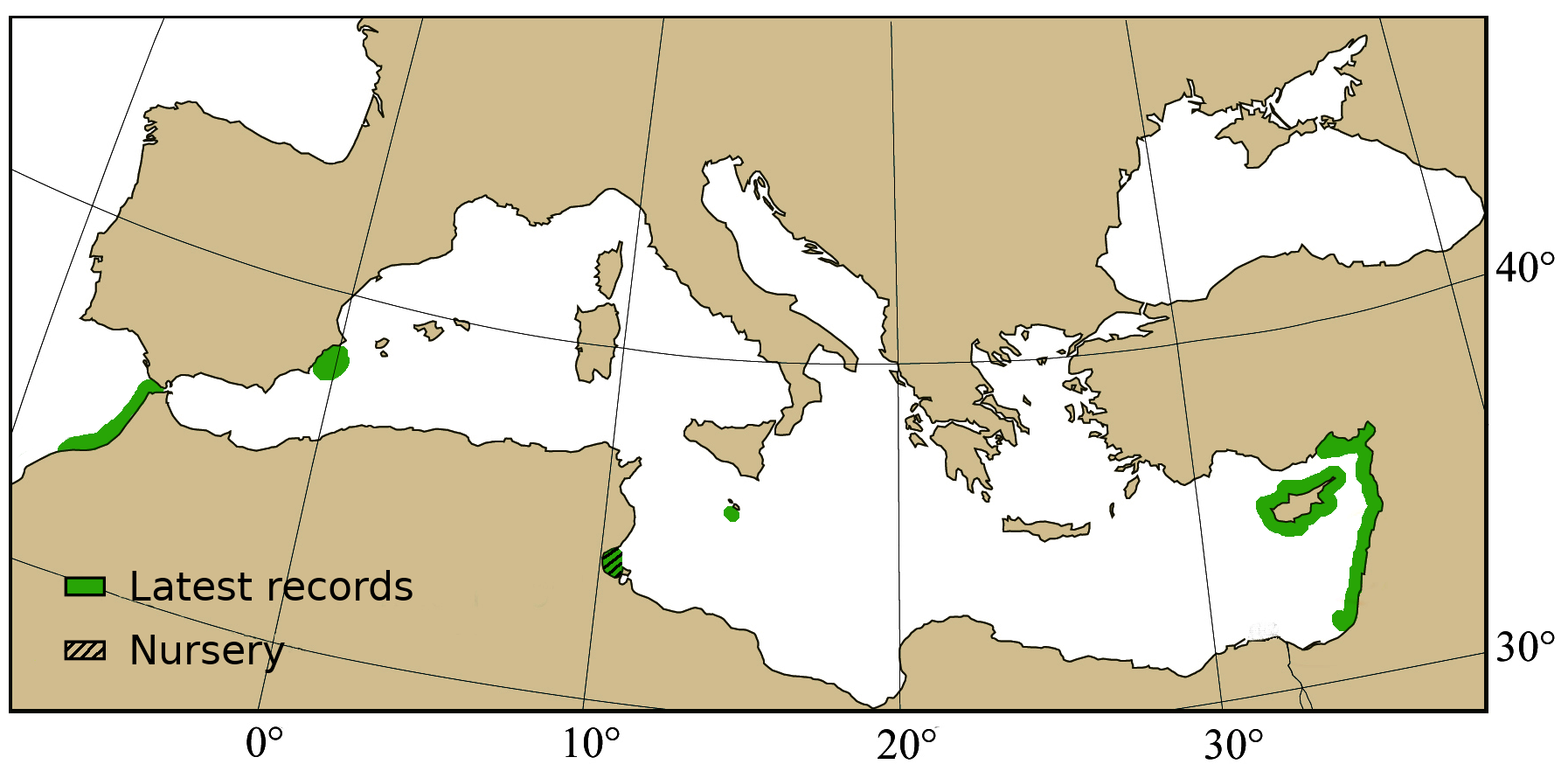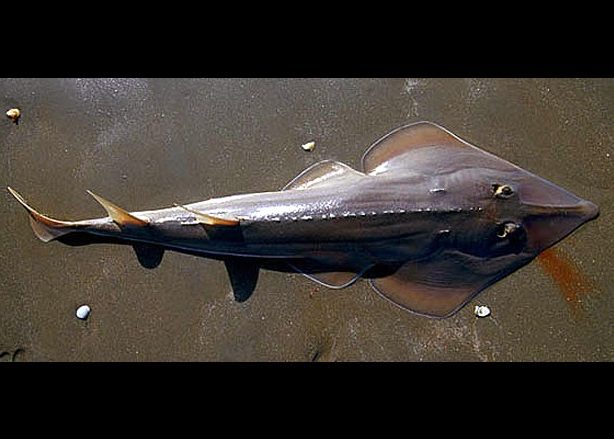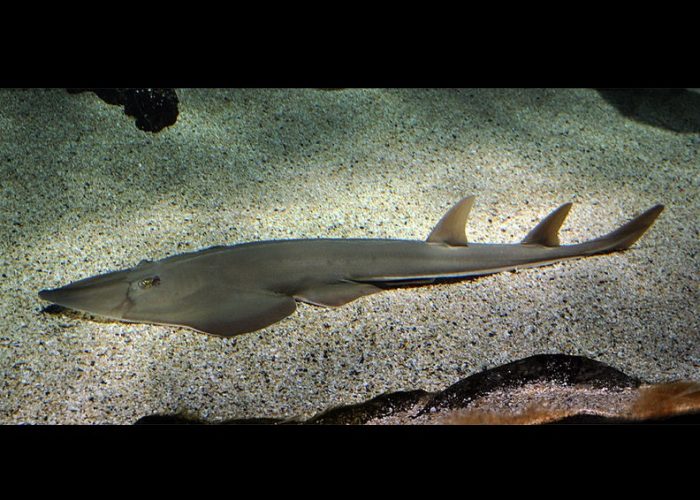Rhinobatos rhinobatos
- Common name : Common Guitarfish, Violin-Fish
- Order: Rhinopristiformes
- Family: Rhinobatidae
- Synonyms: Raja rhinobatos
- Misidentifications: None
Short description
Medium-sized guitarfish. Elongated tubular body. Head, body and pectoral fins are combined in a triangular disc, with rostral ridges widely separated. Spiracles with two developed folds. Little spines around orbits and spiracles, on shoulders and along the midline until the tail. Females seem to be larger than males.
Color: Khaki-brown dorsal surface. White ventral surface.
Measurements:
- Total length (TL): ~100 cm (max 181 cm).
Swimming pattern: Axial-undulatory locomotion.
Biology / Ecology
Feeds on benthic invertebrates, mainly crustaceans and small fishes.
Reproduction: Viviparous (aplacental viviparity). Size at maturity (TL): 64 cm female, 56 cm male at 2-3 years. Gives birth in late summer to early autumn. 1 or 2 litters per year with 4-10 juveniles per litter. Size at birth (TL): 25-34 cm.
Habitat: Benthic species inhabits sandy and muddy bottoms, seabeds and sometimes rocky reefs, from the intertidal zone to depth of 100 m.
Generally ambush crustaceans and small fish by pinning them down with their long snouts and then sucking them into their mouths.
Distinguishing characteristics
- Spiracles with 2 folds.
- Rostral ridges widely separated.
- Distance between rostral ridges equal to eyes diameter.
Rhinobatidae: Snout elongated and pointed. Strongly depressed trunk. Pectoral fins enlarged.
Distribution
Worldwide: Atlantic, from southern Bay of Biscay to Angola.
Mediterranean: Southern Mediterranean basin, from Tunisia to Turkish. A laying area has been identified from the Gulf of Gabès. One recent record from the Black Sea.
- Occurence: Abundant.
- Latest records: Cyprus (2018-2022), Gulf of Gabes – Tunisia (2019, 2007-2008), Atlantic – Morocco (2016), Iskenderun bay – Turkey (2012-2014), Lebanon (2013), Mersin bay – Turkey (2011), Syria (2003).

Any recent observation not on the map?
Contact us!
Conservation
Threats: High fishing pressure from West Africa. Taken as bycatch by bottom trawlers in the Mediterranean Sea.
Protection level:
- Mediterranean: Endangered (IUCN 2016, last assessment: 2016)
- Global: Critically Endangered (IUCN 2021, last assessment: 2020)
- Europe: Endangered (IUCN 2015, last assessment: 2014)
Key references
- Başusta N., Demirhan S., Çiçek E., Başusta A, Kuleli T. 2008. Age and growth of the common guitarfish, Rhinobatos rhinobatos, in Iskenderun Bay (north-eastern Mediterranean, Turkey). Journal of the Marine Biological Association of the United Kingdom 88(4): 837–842
- Carpentieri P., Nastasi A., Sessa M., Srour A. 2021. Incidental catch of vulnerable species in Mediterranean and Black Sea fisheries – A review. General Fisheries Commission for the Mediterranean – Studies and Reviews 101: I-317.
- Genc E., Yildirim Y.B., Basusta N, Cekik M. 2006. Seasonal variation of Hysterothylacium aduncum infection in the common guitarfish, Rhinobatos rhinobatos in Iskenderun Bay (north-easthern Mediterranean Sea) Turkey. In : Proc. of the Int. Workshop on Med. Cartilaginous Fish with Emphasis on South.- East. Med., 14-16 Oct. 06, Istanbul-Turkey.
- Giovos I., Serena F., Katsada D., Anastasiadis A., Barash A., Charilaou C., Hall-Spencer J.M.,Crocetta F.,Kaminas A., Kletou D, Maximiadi M., Minasidis V., Moutopoulos D.K., Aga-Spyridopoulou R.N., Thasitis I., Kleitou P. 2021. Integrating literature, biodiversity databases, and citizen-science to reconstruct the checklist of Chondrichthyans in Cyprus (Eastern Mediterranean Sea). Fishes 6(3): 24.
- Gökçe G., Bozaoğlu A.S. Eryaşar A.R., Özbilgin H. 2016. Discard reduction of trammel nets in the northeastern Mediterranean prawn fishery. Journal of Applied Ichthyology 32(3): 427-431.
- O’Keefe M., Bengil EG., Palmer JL, Beton D, Çağlar Ç., Godley B.J, Özkan M., Snape R.T.E., Broderick A.C. 2023. Diversity and distribution of elasmobranchs in the coastal waters of Cyprus: using bycatch data to inform management and conservation. Front. Mar. Sci. 10: 1181437.



